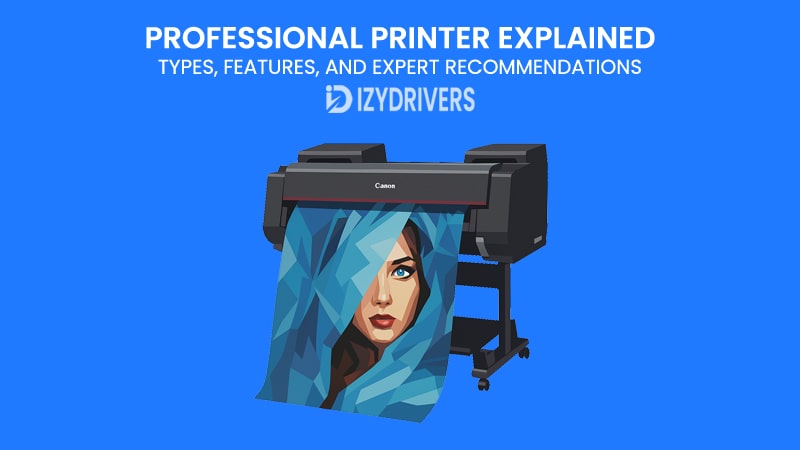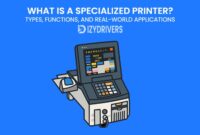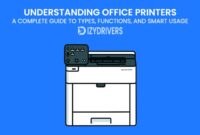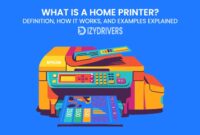If you’ve ever stood by a sluggish printer, waiting for pages that seem to take forever, you’ll understand why professionals invest in something better. A professional printer isn’t just a fancy office gadget — it’s a workhorse built for people who print a lot, need perfect results, and can’t afford downtime. Designers, architects, photographers, small business owners — they all rely on these machines to keep projects moving smoothly.
Unlike the compact printer sitting in a corner of your home printer office, a professional model is designed for volume and precision. It doesn’t flinch when you send a hundred-page document at once, and it doesn’t wash out colors halfway through a presentation deck. Everything about it — from the ink system to the print engine — is tuned for accuracy and consistency.
The difference shows the moment you start using one. Colors are richer, blacks are deeper, and text edges look razor-sharp. In creative industries, that accuracy matters. A professional photo printer, for instance, can reproduce the subtle tones of a landscape shot that a standard printer simply can’t. In corporate settings, a professional laser printer can churn out thousands of crisp pages every week without breaking a sweat.
But it’s not just about speed or print quality. It’s also about workflow. Most professional printers today come with smart features — wireless connectivity, cloud printing, automated maintenance routines — that quietly keep your day running. You hit “print,” and it just works.
And that’s the real value here: reliability. Professionals don’t want surprises; they want results they can trust, again and again.
Throughout this guide, we’ll unpack what makes these printers different, the types you’ll encounter, the features that actually matter, and some expert recommendations worth considering in 2025. Whether you’re upgrading from a midrange office printer or buying your first professional model, this article will help you choose the right tool — one that fits the way you work and grows with your needs.
Understanding Professional Printers
Before diving into models and specs, it helps to understand what the phrase “professional printer” really means. It’s easy to assume it’s just a bigger, pricier version of the desktop printer you already have — but that’s only half true. A professional printer is engineered differently. It’s built to deliver speed, precision, and consistency over long stretches of work, not just for the occasional print job or weekly invoice.
Think of it this way: a consumer printer is like a compact car — efficient, affordable, and perfect for light use. A professional printer, on the other hand, is more like a reliable van built for daily hauling. It’s designed to run longer, handle heavier workloads, and deliver the same performance day after day. You’re not paying for extra bells and whistles; you’re paying for endurance, accuracy, and control.
What Makes a Printer “Professional”?
At its core, a professional printer stands out for three things: build quality, output consistency, and advanced control.
These machines use robust mechanical parts — heavy-duty rollers, precision printheads, and motors that don’t wear out easily. They’re calibrated to produce exact color and line details with every print, which is crucial for industries where visual accuracy isn’t negotiable.
For example, a design studio can’t risk color drift between proofs. The red on a client’s logo must be the same red every single time. Professional photo printers, such as Canon’s imagePROGRAF or Epson’s SureColor line, achieve this level of reliability through pigment-based inks and sophisticated color management systems.
In contrast, consumer-grade printers often rely on dye-based inks that fade faster and show slight color variations depending on paper type or humidity.
Professional printers also give users more control. You can tweak profiles, manage media settings, and run calibration tests — all from an integrated control panel or desktop software. It’s the kind of customization pros need, and the kind casual users might never touch.
How Professional Printers Differ from Consumer Models
The difference isn’t just in performance — it’s in philosophy. Consumer printers are built for convenience; professional printers are built for results.
Here are a few distinctions that stand out in real-world use:
- Speed and volume: Professional models print faster and can handle thousands of pages a month without performance drops.
- Material flexibility: They support various media — from thick card stock to glossy photo paper or large-format rolls.
- Maintenance design: Parts are modular and replaceable, so downtime is minimal.
- Color accuracy: They often include more ink channels (6–12 instead of 4), allowing for smoother gradients and lifelike hues.
That’s why businesses and creators alike see them as investments rather than expenses. The upfront cost might be higher, but the long-term efficiency, durability, and print quality make up for it many times over.
Who Uses Professional Printers?
You’ll find professional printers in a wide range of environments — from small offices to art studios and print shops.
- Corporate offices use them for bulk document handling and reports.
- Designers and photographers depend on them for true-to-life color output.
- Architects and engineers rely on large-format models for blueprints and technical drawings.
Each profession pushes a printer differently, but the expectation is always the same: speed, accuracy, and dependability.
In short, understanding what makes a printer “professional” is the first step toward buying wisely. Once you know how they’re designed and who they’re meant for, it’s easier to match a machine to your workflow. In the next section, we’ll explore the different types of professional printers — from high-end inkjets and lasers to wide-format beasts built for serious print production.
Types of Professional Printers
Walk into any print shop, creative studio, or busy office, and you’ll notice something: not all professional printers look or perform the same. Some are compact yet powerful; others are massive machines that hum quietly while spitting out posters the size of a door. The reason is simple — “professional printer” is an umbrella term. There isn’t one single kind; there are many, each designed for a different type of printer work.
Understanding the types of professional printers helps you choose one that actually fits your workflow, rather than overpaying for features you’ll never use.
Inkjet vs. Laser: The Core Divide
At the heart of professional printing, there are two main camps — inkjet and laser.
Inkjet printers work by spraying microscopic droplets of liquid ink onto paper. They’re known for producing vibrant colors and smooth gradients, making them a favorite among photographers, artists, and designers. Professional inkjet printers like the Epson SureColor P900 or Canon imagePROGRAF PRO-1000 can handle wide color gamuts and even print borderless images up to A2 size. They use pigment-based inks, which resist fading and deliver gallery-quality results.
Laser printers, on the other hand, use powdered toner fused to paper through heat. The process is faster, cleaner, and far more efficient for text-heavy work. Professional laser printers — such as the HP LaserJet Pro MFP 4301fdw or Brother HL-L9310CDW — are the backbone of most corporate environments. They can print thousands of crisp, smudge-free pages per month without flinching.
If you’re printing reports, invoices, or mixed documents all day, a professional laser printer will outpace any inkjet in the long run. But if color accuracy and image detail are your top priorities, the professional inkjet printer is the way to go.
Professional Photo Printers
For photographers, illustrators, and digital artists, a professional photo printer is a creative partner — not just a machine. These printers go beyond the standard CMYK system, often adding extra ink colors like light magenta, gray, or red to achieve smoother tonal transitions. The result? Prints that look exactly like the images on your calibrated monitor.
Take the Canon imagePROGRAF PRO-300, for example. It produces stunning color depth and detail that can rival traditional lab prints. Epson’s SureColor P9570 goes even further, offering 12-color UltraChrome PRO inks for unmatched precision and dynamic range.
Another key advantage is media versatility. You can print on fine art paper, glossy photo sheets, canvas, or even metallic media. Professional photo printers give creators complete control over the final product — every highlight, every shadow, every subtle hue.
These printers aren’t cheap, and they require maintenance to keep printheads clean. But for anyone who sells prints or delivers visual work to clients, the investment pays for itself in professional credibility and color consistency.
Wide-Format and Plotter Printers
Step into an architecture firm or engineering office, and you’ll likely find a wide-format printer (sometimes called a plotter). These machines specialize in producing large-scale prints — blueprints, CAD drawings, posters, and banners — often up to 44 inches wide or more.
A great example is the HP DesignJet T850, capable of printing technical line drawings with pinpoint accuracy, as well as vivid full-color posters. Epson’s SureColor T7770D is another powerhouse, blending speed with fine detail, perfect for architectural visualization and graphic production.
What sets wide-format printers apart is their ability to handle roll media. You’re not limited to standard A4 or A3 sheets — you can feed in a continuous roll of paper or vinyl, making them indispensable for sign makers, event organizers, and marketing teams.
These printers often support specialized ink sets optimized for durability, UV resistance, or even waterproof output — ideal for outdoor signage or display materials.
Multifunction Professional Printers (MFPs)
Not every professional printer is about art or large-format output. Some are built for everyday office efficiency. Enter the multifunction professional printer, often shortened to MFP.
These machines combine printing, scanning, copying, and faxing into one unit, making them the Swiss Army knife of the modern office. The best models, like the Canon imageRUNNER ADVANCE DX series or HP Color LaserJet Enterprise Flow, come with touchscreen interfaces, fast duplex scanning, and tight security integrations — features that help teams stay productive and protect sensitive data.
Beyond convenience, MFPs save space and streamline workflows. Many support cloud integration, letting users print or scan directly from Google Drive, Dropbox, or OneDrive without touching a computer. For small businesses and busy offices, this all-in-one capability is a game changer.
Choosing the Right Type for Your Workflow
So, which one do you need? The answer depends on your daily tasks:
- Designers & Photographers: Go for a high-end professional inkjet or photo printer with pigment inks.
- Corporate Offices & Small Businesses: Choose a professional laser printer or multifunction printer for speed and volume.
- Architects, Engineers & Creators: Opt for a wide-format printer to handle large drawings or promotional graphics.
Each type has its strengths — the key is to match it to your output needs, budget, and space.
In short, professional printers aren’t defined by how expensive or bulky they are. They’re defined by purpose. Inkjet, laser, photo, wide-format, or multifunction — each serves a specific professional demand. And once you find the right match, you’ll realize it’s not just a machine; it’s an extension of how you work.
Essential Features to Look For Professional Printer
Buying a professional printer isn’t just about picking the right brand or model — it’s about understanding what’s under the hood. Two printers might look identical on the outside, but their internal specs and feature sets can make a world of difference once you start printing day in, day out. Below are the features that truly matter when choosing a professional printer — the ones that separate long-term reliability from short-term regret.
Print Quality and Resolution
Let’s start with the heart of it all: print quality. For professionals, this isn’t a luxury — it’s non-negotiable.
Print resolution, measured in DPI (dots per inch), tells you how finely a printer can reproduce detail. The higher the DPI, the sharper your images and text. Consumer printers often hover around 600–1200 DPI, while professional printers can easily reach 2400 or even 4800 DPI, depending on the technology.
But resolution alone doesn’t define quality. The type of ink or toner, the precision of the printhead, and the printer’s color management system all play critical roles.
- Inkjet printers rely on microscopic nozzles to produce rich gradients and vibrant tones — perfect for photos or design proofs.
- Laser printers use toner fusion for ultra-crisp text, ensuring that contracts, reports, and presentation materials look sharp and professional.
For graphic work, look for printers that support ICC color profiles and pigment-based inks — they deliver more consistent and fade-resistant results.
Speed and Duty Cycle
Professional environments don’t have time to wait. A printer’s speed, measured in pages per minute (PPM), determines how quickly you can move from draft to delivery. But speed is only half the story — duty cycle is what tells you how much workload a printer can handle without breaking down.
A consumer printer might have a duty cycle of 1,000 pages per month. A professional laser printer? Try 50,000 or more. This figure matters if you’re running a business that prints daily reports, invoices, or marketing materials.
Also, look for first-page-out time (FPOT) — the time it takes for the first sheet to emerge after hitting “Print.” A high-end printer might do this in 6–8 seconds. It seems small, but over hundreds of print jobs, it adds up to hours saved.
Connectivity and Smart Features
Modern professional printers aren’t isolated machines anymore — they’re connected hubs within a digital workflow.
Wi-Fi and Ethernet are a given, but look for NFC tap-to-print, Bluetooth, or USB Direct Print if you need flexible access. Many models now integrate seamlessly with cloud platforms like Google Drive, OneDrive, or Dropbox, so your team can print directly from the cloud without ever opening a laptop.
Mobile printing is also key. Apps like Canon PRINT, HP Smart, and Epson Connect let you print, scan, or monitor supplies right from your phone — handy for hybrid workers or small offices with rotating teams.
Some professional printers even use AI-based diagnostics to detect potential issues early. They can alert you when toner is running low, recommend maintenance, or schedule automatic firmware updates to keep performance optimal. These smart touches reduce downtime and keep workflows smooth.
Ink and Toner Efficiency
Printing costs can sneak up on you — fast. Ink and toner aren’t cheap, and in high-volume environments, they often make up the bulk of your long-term printing expense. That’s why efficiency should be a top priority.
Look for models with high-capacity cartridges or refillable ink tanks. Epson’s EcoTank and Canon’s MegaTank systems, for instance, can print thousands of pages before needing a refill — a huge win for businesses that print frequently.
Laser printers tend to have lower cost per page (CPP) compared to inkjets, especially for monochrome output. Some business-class models can print for as little as $0.02 per page, thanks to large toner yields and automatic duplexing.
Don’t overlook energy efficiency either. Printers with Energy Star or Blue Angel certifications consume less power, which means lower utility costs and a lighter environmental footprint over time.
Build Quality and Durability
A professional printer isn’t meant to be replaced every two years. It should be a durable workhorse that can withstand the daily grind.
Look for a solid frame construction, sturdy trays, and well-designed feed mechanisms. A flimsy paper tray or noisy roller is often a sign of poor build quality. Brands like Brother, Epson, and Canon typically reinforce their professional models with metal components in high-stress areas, ensuring smooth paper handling even under heavy use.
Durability also extends to software. Some professional printers feature remote management dashboards that allow IT teams to monitor multiple devices, track usage, and manage security settings from a central console — a must for medium to large offices.
Ease of Maintenance
Maintenance is where many buyers underestimate the total cost of ownership (TCO). A cheaper printer might save you a few hundred dollars upfront but cost you thousands in downtime or service calls later.
Professional printers are designed for easy access — removable printheads, front-loading toner, and modular drum units make servicing much faster. Many also support self-cleaning cycles and automated calibration routines to prevent color drift and clogged nozzles.
Some high-end models even log maintenance history and alert you when parts are near the end of their lifespan, so you can plan replacements proactively instead of reacting to failures.
Security and Workflow Integration
In professional settings, data security isn’t optional. Many modern printers now come with built-in encryption, user authentication, and secure print release features. That means documents aren’t printed until the authorized user confirms at the device — a small but crucial safeguard for sensitive files like contracts, invoices, or client data.
For offices using cloud systems or project management tools, check compatibility with APIs or add-on integrations. The smoother your printer fits into your existing workflow, the less friction your team will experience.
Putting It All Together
When you combine these features — print quality, speed, efficiency, connectivity, and durability — you get a machine that’s more than just a printer. It’s a productivity platform.
Professionals don’t choose printers based on looks or brand hype; they choose based on performance and reliability. A printer that delivers consistent output, minimal downtime, and predictable costs is one that pays for itself many times over.
Top Expert Recommendations of Professional Printer (2025 Update)
Choosing the right professional printer isn’t just about picking the latest model or the most expensive one. It’s about understanding your workflow, your volume, and the kind of output you need. To help professionals make an informed choice, we’ve grouped the top printers of 2025 by category: Inkjet, Laser, Photo, Wide-Format, and Budget-Friendly. Each recommendation balances reliability, performance, and total cost of ownership.
1. Professional Inkjet Printers
Inkjet printers are the go-to choice for professionals who prioritize color accuracy, fine details, and media versatility. They are particularly suitable for photographers, designers, and creative studios.
| Model | Max Print Size | Key Features | Ideal For |
|---|---|---|---|
| Epson SureColor P900 | 17 inches | UltraChrome PRO10 pigment inks, borderless printing, advanced color calibration | Photographers, graphic artists |
| Canon imagePROGRAF PRO-1000 | 17 inches | Lucia PRO 12-color ink system, high-resolution prints, wide gamut | Fine art prints, design proofs |
| Epson EcoTank ET-8550 | 13×19 inches | Refillable ink tanks, low cost per page, supports heavy media | Small studios, creative professionals |
These printers excel in color fidelity, smooth gradients, and consistent results over long print runs. They often include advanced color management tools, allowing professionals to replicate precise tones across multiple projects.
2. Professional Laser Printers

Laser printers are built for speed, efficiency, and high-volume text or mixed output. They are ideal for offices and businesses where productivity and reliability are paramount.
| Model | Print Speed (PPM) | Duty Cycle | Key Features | Ideal For |
|---|---|---|---|---|
| HP Color LaserJet Pro MFP M283fdw | 22 PPM | 30,000 pages/month | Multifunction, wireless, secure printing | Office environments, business users |
| Brother HL-L9310CDW | 33 PPM | 50,000 pages/month | High yield toner, duplex printing, robust security | Medium-to-large offices |
| Canon imageCLASS LBP6230dw | 26 PPM | 20,000 pages/month | Compact, wireless, affordable toner | Small offices, home offices |
Laser printers deliver sharp text and consistent quality for document-heavy workflows. They are also more cost-effective for high-volume black-and-white printing and tend to have lower long-term maintenance requirements compared to inkjets.
3. Professional Photo Printers
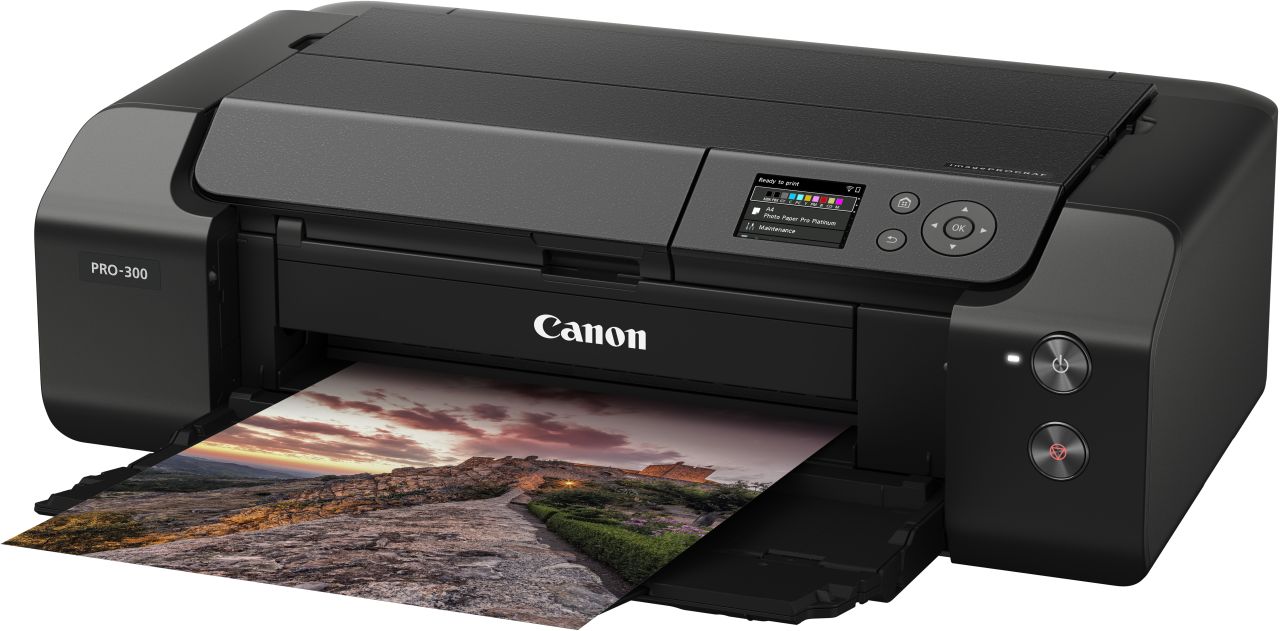
Professional photo printers cater to photographers, visual artists, and anyone requiring precise color reproduction. They often support specialized printer media and pigment inks for longevity.
| Model | Max Resolution | Key Features | Ideal For |
|---|---|---|---|
| Canon imagePROGRAF PRO-300 | 4800 DPI | Lucia PRO inks, borderless photo printing | Professional photography, gallery prints |
| Epson SureColor P9570 | 2400 DPI | 12-color UltraChrome PRO inks, wide color gamut | High-end photography, fine art prints |
| Canon PIXMA PRO-200 | 4800×2400 DPI | Compact, wireless, affordable ink | Emerging photographers, small studios |
Photo printers emphasize smooth gradients, accurate skin tones, and archival-quality output. They may also support creative media, such as canvas, metallic paper, or textured art sheets.
4. Wide-Format & Plotter Printers

Wide-format printers are essential for architects, engineers, and large-format graphics professionals. They handle prints that go beyond standard sheet sizes.
| Model | Max Width | Key Features | Ideal For |
|---|---|---|---|
| HP DesignJet T850 | 36 inches | Fast CAD plotting, vibrant color, roll media | Architecture, engineering, signage |
| Epson SureColor T7770D | 44 inches | Dual roll support, precise line work, high-speed | Engineering drawings, banners |
| Canon imagePROGRAF TX-3000 | 36 inches | Technical plotting, CAD/CAM support | Technical offices, production studios |
These printers are capable of handling continuous roll media, wide-format posters, and detailed technical drawings. They balance speed with precision, making them indispensable in professional design environments.
5. Budget-Friendly Professional Printers

Not all professionals need ultra-high-end machines. Some require dependable printers that balance cost, performance, and durability.
| Model | Type | Key Features | Ideal For |
|---|---|---|---|
| Brother MFC-J995DW | Inkjet MFP | INKvestment tank, low cost per page, wireless | Small offices, startups |
| HP LaserJet Pro M404dw | Laser | Fast printing, compact design, secure printing | Cost-conscious office users |
| Epson EcoTank ET-4760 | Inkjet MFP | Refillable tanks, multifunction, cloud print | Home office, small businesses |
Budget-friendly printers may lack the advanced color management or media versatility of high-end models, but they excel at reliability, efficiency, and total cost savings — perfect for smaller teams or individuals.
Setup & Maintenance Tips Professional Printer
Buying a professional printer is only half the battle. The other half? Knowing how to set it up, maintain it, and troubleshoot issues so it continues delivering top-quality results year after year. Even the most advanced printer can underperform if neglected, so understanding proper setup and care is essential for any professional environment.
Proper Installation and Calibration
When unboxing a new professional printer, it’s tempting to just plug it in and start printing. But taking the time to install and calibrate it properly can make a huge difference in output quality and long-term performance.
- Follow the manufacturer’s guide step by step: Professional printers often have multi-part setups involving software, drivers, and network configurations. Skipping steps can cause connectivity issues or subpar printing.
- Use genuine inks or toners: While third-party supplies may seem cheaper, they can clog printheads, produce inconsistent colors, and void warranties.
- Calibrate before the first print: Most professional printers include built-in calibration tools for color, alignment, and paper handling. Running these ensures your first print looks exactly like your design or document.
- Check network and cloud integration: If your printer supports Wi-Fi, Ethernet, or cloud printing, test connectivity early. Confirm mobile printing apps and driver installations are working across all devices in your workflow.
Proper initial setup may take extra time, but it prevents headaches later and ensures every page comes out at its best.
Regular Maintenance Practices
Even the most reliable printer needs routine care. Regular maintenance prevents costly downtime and preserves print quality.
- Clean printheads and rollers: Dust, paper fibers, or dried ink can cause streaks or jams. Some printers have automated cleaning cycles; others require manual attention.
- Replace consumables on schedule: Toner drums, fusers, and ink cartridges have finite lifespans. Keep track of usage to avoid unexpected failures.
- Update firmware and software: Manufacturers release updates that improve performance, fix bugs, and add security features. Staying up to date ensures your printer runs smoothly.
- Environment matters: Keep the printer in a dust-free, temperature-stable area. Humidity, direct sunlight, or heat can affect paper handling and ink performance.
Professional users often maintain a maintenance log, tracking issues, part replacements, and cleaning schedules. Over time, this becomes an invaluable reference for troubleshooting recurring problems.
Common Troubleshooting Tips
Even with careful maintenance, problems can happen. Knowing basic troubleshooting steps saves time and keeps your workflow uninterrupted:
- Paper jams: Always remove paper slowly and according to the manufacturer’s instructions to prevent damage. Check that the paper type and weight are compatible.
- Color inconsistencies: Run a printhead cleaning cycle or recalibrate color profiles. Ensure inks haven’t dried out or mixed.
- Connectivity issues: Restart the printer and router, verify driver updates, and check network settings. For cloud printing, ensure authentication tokens or passwords haven’t expired.
- Slow printing: Check for high-resolution settings that may be unnecessary, ensure firmware is updated, and confirm that toner or ink levels aren’t critically low.
Most professional printers have diagnostic tools built into their software, giving step-by-step guidance for resolving common issues.
Pro Tips for Longevity
Here are some additional strategies professionals use to extend the life of their printers:
- Use it regularly: Printers that sit idle for months are more prone to clogs and dried ink. Even small test prints keep the system functioning.
- Stock essential spare parts: Having extra fusers, drums, or ink cartridges on hand reduces downtime.
- Avoid low-quality paper: Cheap paper can shed fibers, causing jams and premature wear on rollers.
- Schedule periodic deep cleaning: Some studios schedule quarterly cleaning for wide-format or high-volume machines, ensuring optimal performance.
- Train team members: In offices, ensuring everyone knows the correct operating procedures prevents accidental damage.
Integrating Maintenance into Workflow
For small teams or studios, it’s easy to overlook printer care. However, integrating maintenance into the daily workflow pays off in reliability and cost savings:
- Assign a responsible person for weekly checks.
- Keep an easy-to-access maintenance kit nearby (lint-free cloths, cleaning solution, spare cartridges).
- Document any recurring errors and solutions in a shared log.
- Plan for regular calibration sessions for color-critical workflows.
These simple practices reduce downtime, maintain professional output quality, and prolong the printer’s useful life — ensuring you get maximum value from your investment.
In short, even the best professional printer won’t live up to its potential without careful setup and ongoing maintenance. From installation to daily care, calibration, and troubleshooting, a few proactive steps can save hours of frustration, preserve color accuracy, and keep every print looking professional.
When combined with the right printer type and features, following these maintenance practices ensures your investment works reliably — whether you’re running a creative studio, office, or photography business.
Conclusion
Choosing the right professional printer is more than just picking the newest model or a well-known brand. It’s about understanding your workflow, volume, and the type of output you need. From inkjet and laser to wide-format and multifunction printers, each category offers unique advantages tailored to specific professional needs.
Professional printers are designed to deliver consistent, high-quality results over long periods, handle large workloads, and integrate seamlessly into modern workflows. Investing in the right printer doesn’t just save time — it preserves the integrity of your work, enhances efficiency, and ultimately supports your professional reputation.
Equally important is maintenance and care. Proper setup, regular calibration, and proactive troubleshooting ensure your printer performs reliably, reducing downtime and extending its lifespan. By combining thoughtful selection with diligent upkeep, you’re not just buying a printer — you’re investing in a tool that empowers your work every day.
Whether you’re a photographer, designer, engineer, or office manager, understanding the types, features, and best practices for professional printers helps you make informed decisions that balance performance, cost, and longevity.
FAQs About Professional Printer
What makes a printer “professional”?
A professional printer is built for high-volume, high-quality output, often featuring faster speeds, greater durability, enhanced color accuracy, and advanced connectivity options compared to consumer printers. It’s designed for consistent performance in demanding workflows.
Are professional printers worth it for small businesses?
Yes. Even small businesses benefit from reliability, lower long-term costs, and better output quality. Features like high-capacity ink or toner systems, multifunction capabilities, and smart connectivity make professional printers a solid investment.
Which is better: professional inkjet or laser printer?
It depends on your needs. Inkjet printers excel in color accuracy and detailed graphics, making them ideal for photographers and designers. Laser printers are faster, more efficient for text-heavy documents, and handle higher volumes, making them perfect for offices.
How long do professional printers typically last?
With proper maintenance, professional printers can last 5–10 years or more. Factors include usage volume, maintenance practices, and build quality. Regular calibration and cleaning extend lifespan and maintain print quality.
How can I reduce maintenance costs on a professional printer?
Use genuine or high-yield cartridges to avoid frequent replacements.
Keep the printer clean and dust-free.
Schedule routine maintenance and calibration.
Monitor usage and replace parts proactively to prevent downtime.

